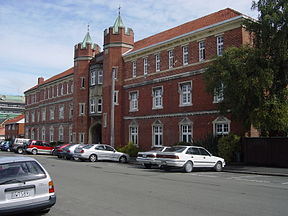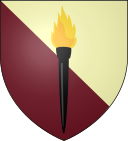User:Philtweir/Selwyn College, Otago
| Colleges of the University of Otago Selwyn College | ||||||||||||

| ||||||||||||
|
| ||||||||||||
| College name | Selwyn College | |||||||||||
| Founders | Bishop Nevill | |||||||||||
| Established | 1893 | |||||||||||
| Status | Affiliated | |||||||||||
| Warden | Rev David Clark | |||||||||||
| Undergraduates | 160 (approx) | |||||||||||
| Graduates | 0 | |||||||||||
| Location | Castle St | |||||||||||

| ||||||||||||
| 'Vitai Lampada Tradunt' (Latin, "They Hand on the Torch of Life") | ||||||||||||
| College website | ||||||||||||


Selwyn College is part of the University of Otago in Dunedin, New Zealand. It was founded by Bishop Samuel Tarratt Nevill as a theological college training clergy for the Anglican Church and as a hall of residence for students attending the university. It is named after George Augustus Selwyn, the first Bishop of New Zealand and is affiliated to the Anglican Diocese of Dunedin. It was opened on 15 January 1893.[1][2] It was Otago's first residential college and on the model of an English university college it included students of all subjects.[3] Women were admitted in 1983. The main building is listed as a Category II Historic Place.[4] Selwyn is one of the most popular colleges in Dunedin,[1] its 160 available places oversubscribed every year.[1]
Building history
[edit]The college is sited behind the Anglican All Saints church on Cumberland Street which is both the college chapel and with the college buildings forms a larger Anglican precinct. The church's nave and baptistery were opened in 1865, designed by the partnership of Mason & Clayton although it is not entirely clear if William Mason (William Mason (architect)) or W.H. Clayton (William Clayton (architect)) was responsible. Some sources favour Clayton. The transepts and chancel added in 1873 were certainly the work of Mason.[5] The church's principally red brick construction perhaps set the theme for the later complex although its Early English Gothic style (English Gothic architecture) (Gothic revival architecture) is in contrast with the main college buildings' domestic Tudor manner (Tudor style architecture).
All Saints is a significant structure.[6] It reflects the arrival in New Zealand of the influence of the Oxford Movement and The Ecclesiological Society, developments in thought about the Gothic revival epitomised by the work of William Butterfield (1814-1900). His All Saints, Margaret Street in London had been completed in 1859 and one supposes was known to the designers of its Dunedin namesake. The latter's slate roof has been replaced with decramastic tiles and its east and south walls have been rendered in cement which rather spoils its appearance and reduces its complementarity with the principal college buildings. (There are plans to remedy some of these defects.) The old church hall immediately to the north is a wooden structure older than the church which was rendered in cement in the 1960s. The old vicarage site is immediately to the north again but the house on it now forming part of the college quadrangle is of mid 20th century origin.
In 1891 work started on the first college building behind the church and facing Castle Street to the design of J.A. Burnside (1856-1920). It appears to have been complete by October 1892 and was dedicated on the 25th of January the following year.[7] Burnside also designed Transit House, a blue stone mansion in Park Street and the oldest part of the Otago Settlers Museum. His building for the college is the range to the north of the archway, including one of its towers, to first floor height. He seems to have anticipated its later extrapolation into the full range with the central archway and two towers, the arch centred on the unusual, gabled chancel of All Saints. In red brick in the Domestic Tudor Gothic style it uses the same manner employed at Selwyn College, Cambridge which is perhaps not an accident. (Sir Arthur Blomfield's chapel there was completed in 1895.) While modest by comparison, especially this first small portion of the later, larger range, the Castle Street building was a pleasing exercise in the manner and capable of expansion into a more impressive composition.
Just that happened in 1929 to 1930 when Burnside's building was extended into the present range. Adding a third floor to Burnside's structure it formed the arch with its towers and its oriel window and extended in two reaches to the south, the further slightly set back from the street. This was the work of, or certainly supervised by, H. McDowell Smith (1887-1965) and cost 13,840 pounds.[8] There was a dining room on the ground floor with a bay window looking into the quadrangle with good stone lattice work and the interior decorated in period style.[9] The whole building, with its archway, makes a clear reference to Hampton Court Palace in England.
In 1950 and 1956 McDowell Smith was called on again to add another large building to the complex. Sargood Hall, named after a major benefactor, extends at right angles from the southern reach of the Castle Street range to form the south flank of the interior quadrangle. This too is in red brick in the Domestic Tudor style which by this time, after the second world war, represented a bold and expensive decision in New Zealand. The whole project appears to have cost something more than 25,000 pounds.[10] The building is free standing with a narrow passage between it and the Castle Street range. It is two storeyed. Its principal, north face has a central break front with a pleasingly modelled entrance and the Hall's name in raised relief in a stone fascia above. There are also forward reaching fronts at either end of the main elevation.
When the College Board next determined to extend the complex, in 1966, it again wished to build "on traditional lines", that is in period style. It wanted another three storeyed wing to the north of the Castle Street range, perhaps meaning to complete the quadrangle. Its efforts to raise the necessary 80,000 pounds were unsuccessful. It decided instead to build three separate three storeyed residential blocks and commissioned one from Miller, White and Dunn, a Dunedin architectural practice. In the event only one was built, Nevill House, which opened on the 4th of March 1973.[11] This is a small tower, immediately to the north of the Castle Street range and close to the street, of Modernist design. Its concrete framework is visibly expressed and it has red brick infills to contextualise it.
A further extension was made with another free standing building to the north again, to house the library which was completed on the 1st of August 1976. It was called the Northcroft Library, after another generous donor and was designed by John Harrison (b.1935). Amidst controversy the library was dispersed in 1988.[12] This is another Modernist building but now in contrasting materials. The most dissonant structure in the group it has steeply inclined slab roofs and extensive areas of glazing.
In 1988 too the first of three buildings providing self-contained flats was completed, Irvine House. Further to the north Millar House and Newcombe House were completed in 1989.[13] These were all designed by Roger Dodd (1939-2001).[14] Millar and Newcombe Houses face Dundas Street, the thoroughfare linking Castle to Cumberland Street at the north end of the city block containing Selwyn College. The two are linked to form an archway giving access to the quadrangle from the north. All three of these buildings are two storeyed and are finished in unpainted, rendered cement. Their forms are those of hipped roof houses. They are rather plain and the northward linked pair are set behind a brick wall along the street.
In 1993 the archway of the Castle Street range was shut off for security reasons with a large glass wall incorporating a door of the same material. The view from the street to the All Saints chancel remained. It has since been eclipsed by the construction of a solid walled cross way joining the ground floor of each wing through the archway.
There are some other college buildings more or less integral to the group but the Castle Street range and Sargood Hall with their orientation around All Saints church show a sustained and successful effort to build a university hall of residence in the revived Tudor style. If not quite so grand or consistent as its rival Knox College's Opoho suite Selwyn's more modest assembly, at least at its core, is interesting and perhaps more simply attractive.
College notes
[edit]In 1930 Selwyn College and College House (a University of Canterbury hall of residence) began an annual sporting and cultural exchange. This still occurs with the Principal's and Warden's Cup being added into the prize mix after the 1980s. Selwyn does not prefer to be involved with the OUSA Orientation events, such as the toga parade, and alternatively organises its own events, such as the Ori Ball. In 1932, initiations at Selwyn College were started including the Turner Tossing Trophy (now replaced with the Homage Run) and the Leith Run in 1935.[1][15] The Lindski Battle and the 21sters Ball are still annual events at the College and are immensely popular with the residents.
Selwyn College and Knox College also compete for the Nevill Cup, a cultural competition, and the Cameron Shield, a sporting competition. These are intense contests, fiercely fought out each year. As of 2009[update], Selwyn holds the Cameron Shield.
The committee of the Selwyn College Students Association (SCSA) is a group of leading second years who run the College's student life. They have various responsibilities that concern the different roles they are given. The SCSA committee for 2010 are as follows:
- President: James Tait-Jamieson
- Vice President: Thomas Elliot
- Treasurer: Chris McKeeg
- Internal Affairs Representative: Chris Brewer
- Sports Representative: Sam Timbs
- Cultural Representative: Jordan Watts
- Social Representative: Hanafi Zwart
Notable Selwynites
[edit]
|
 |
Other information
[edit]Actor-turned-travel documentary presenter Michael Palin visited the college in his 1996 documentary Full Circle with Michael Palin on his journey through New Zealand.
Sources
[edit]Charles Croot, Dunedin Churches Past and Present Dunedin, NZ; Otago Settlers Association, 1999. ISBN 0-473-03979-6.
Ray Hargreaves, Selwyn College's First Century Dunedin, NZ; Centennial Committee, Selwyn College Board of Governors, 1993. ISBN 0 473 01954 X.
References
[edit]- ^ a b c d Constantine, Ellie (27 February 2009). "Students 'one big family' at oldest hall". Otago Daily Times. Retrieved 2009-02-26.
- ^ Booth, Ken (22 June 2007). "Nevill, Samuel Tarratt 1837 - 1921". Dictionary of New Zealand Biography. Retrieved 2008-07-07.
- ^ "2008 Members Handbook" (PDF). Selwyn College. Retrieved 2008-07-07.
- ^ "Selwyn College Main Building". New Zealand Heritage List/Rārangi Kōrero. Heritage New Zealand. Retrieved 2008-07-07.
- ^ Croot, 1999, p.120.
- ^ It is registered as a category 1 historic place by the New Zealand Historic Places Trust.
- ^ The Otago Daily Times 12 March 1891 carries Burnside's advertisement to erect "College buildings in Castle street"; the Otago Daily Times 7 October 1892 carries an advertisement for tenders from Forrester & Lemon for a parsonage at Kurow which says plans may be seen at "Selwyn College, Dunedin"; Hargreaves 1993 p.9 gives the date of the building's dedication.
- ^ Hargreaves, 1993, p.20.
- ^ Hargreaves, 1993, pp.20-21.
- ^ Hargreaves, 1993, p.22. The cost was supported by the Sargood Bequest of whom Percy Sargood was the principal benefactor.
- ^ Hargreaves, 1993, p.32.
- ^ Hargreaves, 1993, p.50.
- ^ Hargreaves, 1993, p.53.
- ^ Personal communication J.M. Dodd/Peter Entwisle 17/4/2009.
- ^ Harvey, Sarah (2 March 2009). "Students take bath for college". Otago Daily Times. Retrieved 2009-03-01.
